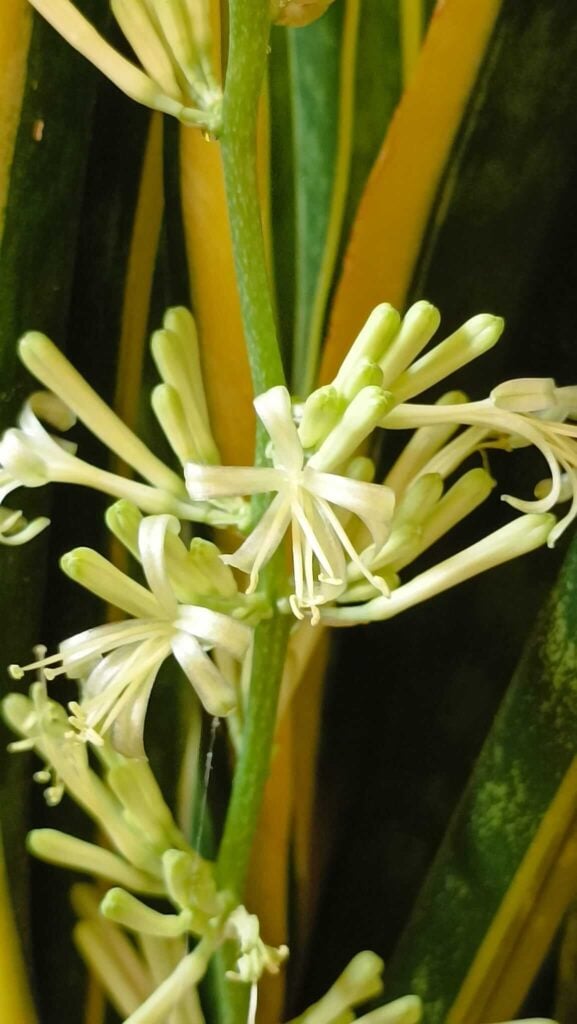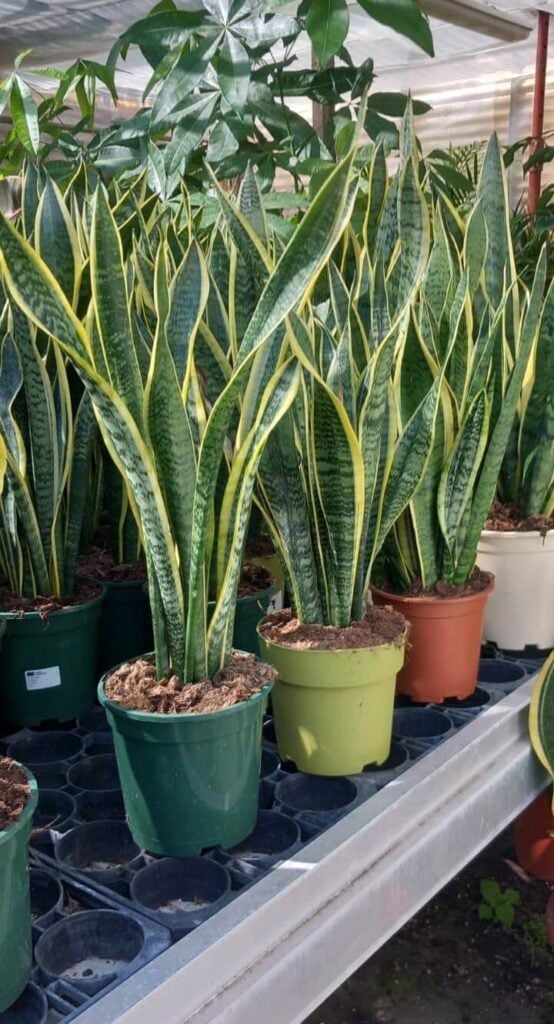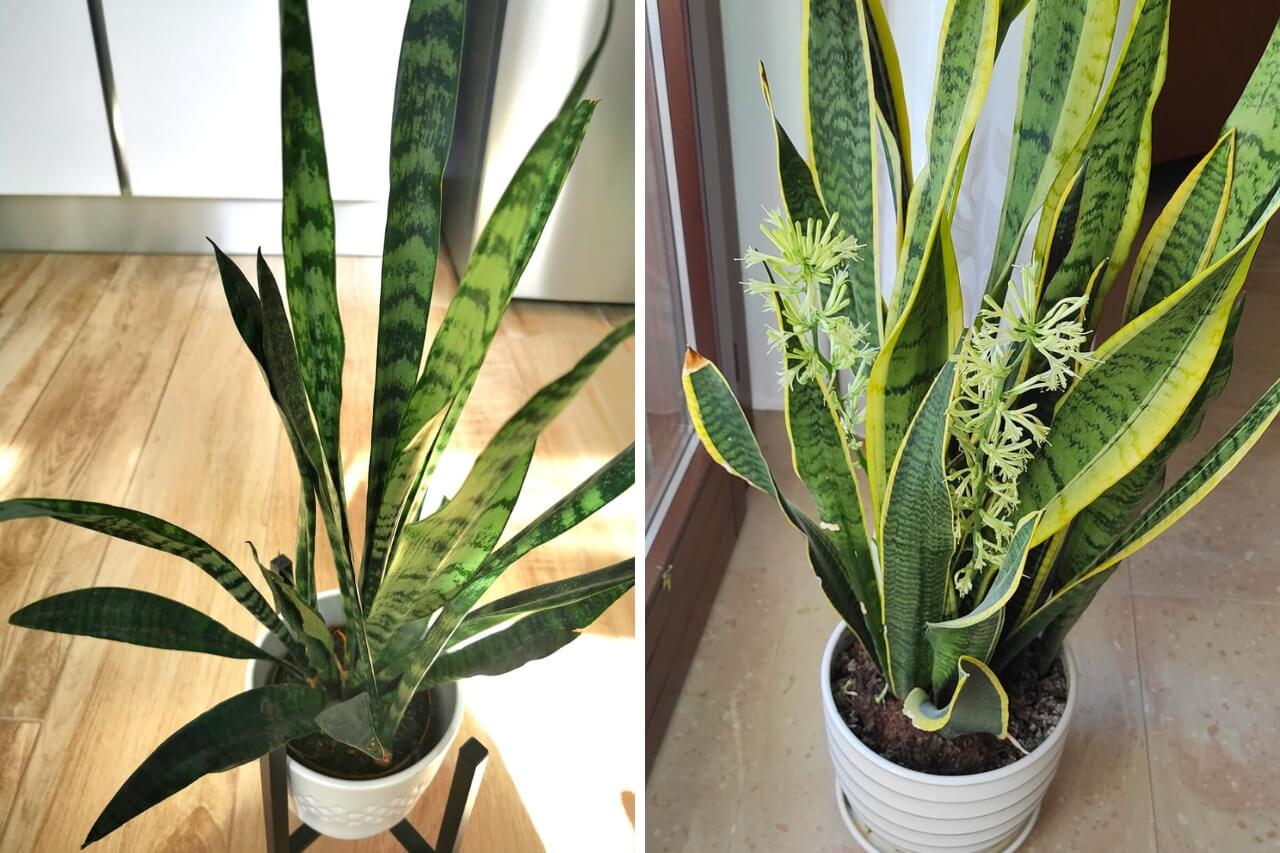Snake plants are famous for being nearly indestructible houseplants with striking upright leaves.
However, what many people don’t know is that these plants can also produce flowers.
Seeing a snake plant bloom is quite rare, and I personally know people who have never seen their plant bloom.
The good news is that with the proper care (and a bit of patience), you can encourage the flowers to appear. Below, I’ll cover the basic facts about snake plant blooms, the conditions they need, and practical steps to help your snake plant flower.
What The Flowers Look Like

When a snake plant blooms, it sends up a tall slender stalk from the base of the leaves, lined with small clusters of white or pale green tubular flowers. I’ll put a photo above.
As you can see, the blossoms aren’t as flashy as a rose or orchid, but they have a unique beauty.
They also have a sweet scent that becomes noticeable at night, I would say similar to jasmine or vanilla.
Another curious thing is that the flowers usually open after dark, starting from the bottom of the stalk upward.
PRO GARDENER: The flowers may even drip sticky nectar; don’t worry, that’s normal.
When and Why They Bloom
In nature, snake plants might bloom during the warm growing seasons.
Indoors, flowering is rare and typically happens only when the plant is mature and conditions are just right.
There’s a popular myth that a snake plant flowering means it’s dying, but that’s not true.
In fact, a bloom usually signals that your plant is happy! It means it’s mature and getting sufficient light, water, and nutrients to have energy for reproduction.
Conditions Needed for Blooming

To encourage a snake plant to bloom, you’ll want to recreate the kind of environment that prompts it to flower.
Key factors include bright light, proper watering, warm temperatures, suitable soil, light feeding, and a bit of patience.
Bright Light and Sunshine
Snake plants are often sold as “low light” plants, but low light won’t encourage blooms.
To form flowers, your plant needs a lot of light. I would say that bright and indirect sunlight for most of the day is ideal.
This could be near a sunny window with filtered light or a few hours of gentle direct sun. Ffor example, morning sun from an east-facing window.
If you have the option, you can even move your potted snake plant outdoors in summer to a partially sunny spot, just avoid harsh midday sun that might scorch the leaves.
If natural light is limited in your home, you can supplement with a grow light to give your snake plant the equivalent of about 5-6 hours of good light per day.
The main point is: light = energy. More light (within safe limits) means your snake plant can photosynthesize more, grow stronger, and reward you with that bloom.
Warm Temperatures

As tropical succulents native to West Africa, snake plants love warmth.
Keep your plant in a warm environment between about 70°F and 90°F (21–32°C) for best growth.
Normal room temperatures suit them fine, but avoid extremes. Do not expose your snake plant to cold drafts or temperatures below 50°F (10°C).
Cold can shock the plant, stunt its growth, and definitely discourage blooming. If you summer your plant outdoors, remember to bring it back inside before any chilly weather hits.
Interestingly, some experts say a bit of day-night temperature fluctuation can mimic the snake plant’s natural habitat and encourage flowering.
You don’t need to do anything special indoors, just find a warm spot away from AC drafts or heater blasts.
Watering Habits
As you probably already know, these plants are drought-tolerant succulents, which means that they store water in their thick leaves.
So use the “less is more” approach with them and water only when the soil has completely dried out.
When you do water, give it a thorough drink so water reaches all the roots, then let all excess drain away.
After that, do not water again until the potting mix is bone dry. Pay attention because in many indoor conditions it means watering perhaps every 2-3 weeks in summer, and even less in winter.
Snake plants actually seem to bloom more often when they experience occasional dry spells like this, but still be careful with extreme neglect.
A snake plant that’s severely parched for too long might lack the nutrients and energy to produce a flower spike.
In general, deep but infrequent watering is the key.
PRO TIP: Always use a pot with drainage holes, and dump out any standing water in the saucer.
Soil and Pot

As I always say, the potting soil and container you use can have a massive impact on your plant. And this is particularly true with snake plants.
First, snake plants hate wet root, so good drainage is a must.
Use a fast-draining, gritty soil mix, similar to what you’d use for cacti or succulents.
If you’re a beginner, just buy a ready-made cactus/succulent potting mix. These mixes contain sand, perlite, or other coarse materials to ensure water doesn’t linger around the roots.
If you use regular potting soil, consider amending it with extra perlite, pumice, small bark chips, or coarse sand to improve airflow and drainage.
If you’re not sure about the mix you’re using, you can do a quick test. Squeeze a handful of your moistened soil mix, then open your hand. If the clump crumbles apart immediately, it’s perfect.
Second, and equally important, is the pot size.
Snake plants actually prefer being a bit root-bound in their pot, and this condition can encourage them to bloom.
In a slightly snug pot, the plant gets a signal to reproduce (and generate flowers) rather than just pushing out more roots and leaves.
So don’t rush to repot your snake plant too often. Repot only every 2–3 years, and only go up to a pot one size larger when you do.
I usually use terracotta pots and definitely recommend them. I know that many people don’t consider them the most beautiful, but the porous clay allows soil to breathe and excess moisture to evaporate.
Time and Maturity
Last but definitely not least, patience is key. You can provide textbook-perfect care and still not see a bloom for a while.
Remember, snake plants need to be mature to bloom. Typically, a snake plant won’t flower until it’s at least a few years old with a robust clump of leaves and roots.
A little nutrition can help, but feed lightly and only during the growing season.
In spring and summer, when your plant is actively growing, you can apply a balanced, general-purpose houseplant fertilizer a few times a year.
Also, remember that snake plants tend to bloom seasonally. As I mentioned above, most indoor blooms appear in spring or summer.
Flowering in winter is quite rare, unless you live in an area that is warm and sunny even in winter.

